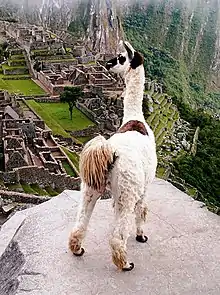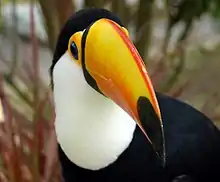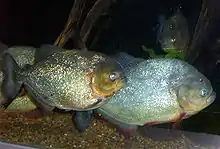The fauna of South America consists of a huge variety of unique animals some of which evolved in relative isolation. The isolation of South America allowed for many separate animal lineages to evolve, creating a lot of originality when it comes to South American animal species.[1] The isolation of South America had an abrupt end some few million years ago when the Isthmus of Panama was formed, allowing small scale migration of animals that would result in the Great American Interchange which caused many marsupials such as Thylacosmilus to go extinct.[2] South America is the continent with the largest number of recorded bird species.[3]
Additionally, speciation has occurred at a higher rate in South America than in other parts of the world.[1] This is likely due to the large amount of land mass close to the equator. The amount of speciation at the equator compared to the rest of the world is much greater.[4]
Types of fauna
Images and Examples
Four examples of animals in South America appear below:

 Toco toucan - Omnivore[6] - Lifespan up to 20 years - Lay 2-4 eggs, both parents incubate[6] - Large bill with serrated edge for capturing and peeling fruit[6]
Toco toucan - Omnivore[6] - Lifespan up to 20 years - Lay 2-4 eggs, both parents incubate[6] - Large bill with serrated edge for capturing and peeling fruit[6] Piranha - Carnivorous fish[7] - Mostly scavengers[7] - Less than 2 feet in size - Most diverse in Amazon River[7]
Piranha - Carnivorous fish[7] - Mostly scavengers[7] - Less than 2 feet in size - Most diverse in Amazon River[7] Jaguar - Cubs live with their mother for 2+ years[8] - Only big cat in the Americas[8] - Mostly found in tropical rainforests, but also savannas and grasslands[8]
Jaguar - Cubs live with their mother for 2+ years[8] - Only big cat in the Americas[8] - Mostly found in tropical rainforests, but also savannas and grasslands[8]
Sources
- Patterson, Bryan; Pascual, Rosendo (1968). "The Fossil Mammal Fauna of South America". The Quarterly Review of Biology. 43 (4): 409–451. doi:10.1086/405916. JSTOR 2819014. S2CID 85357795.
References
- 1 2 3 4 5 6 7 "South America - Wildlife, Ecosystems, Biodiversity | Britannica". www.britannica.com. Retrieved 2023-12-06.
- ↑ What happens when continents collide? - Juan D. Carrillo, TED Conferences, LLC, retrieved 2023-03-21
- ↑ Palmerlee, Danny (2007). South America on a Shoestring. Lonely Planet Publications. p. 275. ISBN 978-1-74104-443-0. OCLC 76936293.
- ↑ Saupe, Erin E.; Myers, Corinne E.; Townsend Peterson, A.; Soberón, Jorge; Singarayer, Joy; Valdes, Paul; Qiao, Huijie (October 2019). "Spatio-temporal climate change contributes to latitudinal diversity gradients". Nature Ecology & Evolution. 3 (10): 1419–1429. doi:10.1038/s41559-019-0962-7. hdl:1983/93e951ff-be06-4365-b76a-7976b96bf5eb. ISSN 2397-334X.
- 1 2 3 "Guanaco | San Diego Zoo Animals & Plants". animals.sandiegozoo.org. Retrieved 2023-12-07.
- 1 2 3 "Toucan | National Geographic". Animals. 2010-09-10. Retrieved 2023-12-07.
- 1 2 3 "Piranha | Description, Size, Diet, Habitat, & Facts | Britannica". www.britannica.com. 2023-11-09. Retrieved 2023-12-07.
- 1 2 3 "Jaguar, facts and photos". Animals. 2010-09-10. Retrieved 2023-12-07.
See also